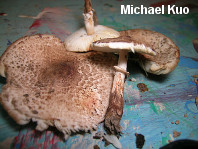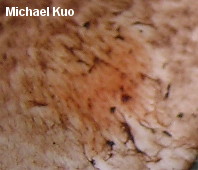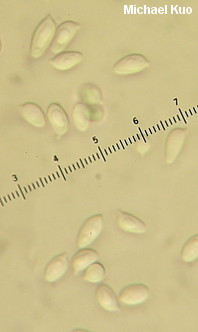| Major Groups > Gilled Mushrooms > Pale-Spored > Lepiotoid Mushrooms > Leucoagaricus brunnescens |

|
Leucoagaricus brunnescens [ Basidiomycota > Agaricales > Agaricaceae > Leucoagaricus . . . ] by Michael Kuo Like other lepiotoid mushrooms, Leucoagaricus brunnescens features a white spore print and gills that are free from the stem. Its cap and stature are reminiscent of many similar species, like the well-known Lepiota cristata. But the surfaces of Leucoagaricus brunnescens turn orange to red, and then slowly brown, when bruised, and the mushrooms darken substantially when dried for the herbarium. To the best of my knowledge this fairly distinctive species has not been described in a contemporary (or even "modern") venue; the original, turn-of-the-century description (Peck, 1904) and Kauffman's 1924 "emended description" are all I can find. But Lepiota expert Walt Sundberg taught me and others the species, and it is regularly recorded and collected for herbaria, despite its absence in the literature. Lepiota brunnescens and Leucocoprinus brunnescens are synonyms. The most current valid name for this species appears to be Leucoagaricus brunnescens, and the mushroom's morphology does suggest the now-outdated concept of Leucoagaricus rather than Leucocoprinus--though recent "molecular data indicate that these two genera are intermingled, and can not be separated" (Vellinga 2004). Description: Ecology: Saprobic, growing alone, scattered or gregariously in both hardwood and conifer forests; late summer and fall; apparently widely distributed in North America from the Great Plains eastward (also recorded a few times by A. H. Smith in California). The illustrated and described collection is from Missouri. Cap: 2.5-7 cm across; convex, becoming broadly convex or nearly flat--but retaining a shallow central bump; dry; scaly overall, with radiating, appressed, fibrillose, brown to pinkish brown scales over a whitish to pale tan ground color; turning red to orange-red, then slowly brown, where bruised. Gills: Free from the stem; close or crowded; short-gills infrequent; creamy white; staining orangish and eventually brown. Stem: 3-5 cm long; about 0.5 cm thick; equal or slightly to moderately club-shaped; hairy; whitish at first, but soon bruising and discoloring red, then brown; with a flimsy, sheathing, collapsing ring that is initially white but becomes stained brown; basal mycelium white. Flesh: White throughout; staining slowly reddish when sliced. Odor and Taste: Not distinctive. Chemical Reactions: Not recorded (oops), but possibly interesting given the affinities to other species; the reaction of the cap and gills to ammonia should be documented. Dried Specimens: Cap, stem, and gills turn dark brown when dried for the herbarium. Spore Print: White. Microscopic Features: Spores 7-9 x 3.5-4.5 µ; ellipsoid to subamygdaliform; smooth; thick-walled; hyaline in KOH; yellowish to dull golden in Melzer's. Cheilocystidia 25-50 x 7.5-10 µ; clavate, subclavate, widely cylindric, or somewhat irregular; thin-walled; hyaline in KOH. Pleurocystidia not found. Pileipellis a a tangle of hyphae 5-15 µ wide, smooth, brownish to brown in KOH, septate; terminal cells cylindric with rounded or subclavate apices. Clamp connections not found. REFERENCES: (Peck, 1904) Bon, 1981. (>Saccardo, 1905; Kauffman, 1924.) Herb. Kuo 09200812. This site contains no information about the edibility or toxicity of mushrooms. |
© MushroomExpert.Com |
|
Cite this page as: Kuo, M. (2015, September). Leucoagaricus brunnescens. Retrieved from the MushroomExpert.Com Web site: http://www.mushroomexpert.com/leucoagaricus_brunnescens.html |


